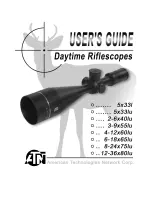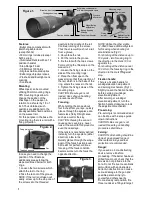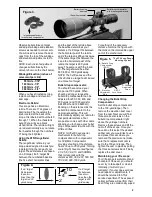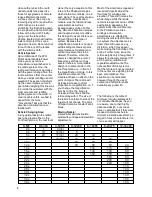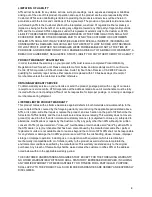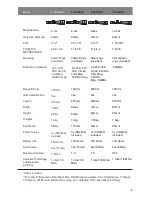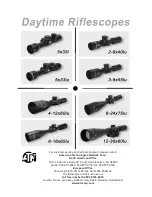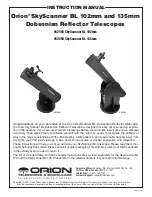
UNIT
2x
4x
6x
8x
10x
12x
14x
16x
18x
20x
22x
24x
26x
28x
30x
32x
34x
36x
2-6x40
1
10
20
3-9x55
4(3x)
10(5x)
17(7x)
25(9x)
4-12x60
6
20
30
60
80
6-18x65
12
25
50
80
115
130
150
8-24x75
25
50
80
115
130
150
180
200
220
12-36x80
40
50
60
70
80
90
100
110
120
130
140
150
160
plane (the only exception to this
rule are the Shepherd scopes
whichcontain two reticles, one in
each plane). The rear focal plane,
or behind the magnification
module, was the initial and less
complicated, as well as
lessexpensive solution. To this
day, almost all American scopes
and inexpensive imports utilize
this design. However, there is an
inherent flaw in this type of
system. Because the
magnification module is housed
within sliding mechanical parts,
some tolerance for lateral and
vertical movement has to be
allowed. Therefore, when the
power is changed the point of
impact may shift as much as
several inches. A more reliable
design is to place reticle in the
front focal plane, i.e. in front of
the magnification module. In this
situation movement of the
module will have no effect on the
point of impact. The reticle will
increase/decrease in direct
proportion to magnification, i.e. if
you change the magnification
from 6x to 18x, the image is
increased three times and the
reticle along with it. The size of
the reticle in relation to size of the
target will not change. The point
of impact remains constant at all
times.
Moving Reticle:
A somewhat similar situation
exists with windage and elevation
adjustments.
Most of the American scopesand
low-priced imports adjust the
front tube for windage and
elevation. This action moves the
whole image while the reticle
remains in apparent center. While
aesthetically appealing, this
system lacks inherent accuracy.
In the Professional series,
windage and elevation
adjustments are effected by
moving the reticle itself. Since in
our system the objective lens is
fixed, there will never be any
distortion, which may appear
while moving the front tube of the
scope. Further more, since the
reticle weighs only a few grams, it
allows for extremely precise (1/8"
at 100 yards), reliable, and
repeatable adjustments. The
optical effect of this system is
that the reticle will not be located
in the center once sighting in has
been accomplished. This
situation can be remedied
however through the use of
vertical and horizontal shims
available any gunsmith.
The following is the table of
minimum focusing distances for
our variable riflescopes. As you
are aware, due to their highly
advanced design, our scopes
have no parallax. But if they were
focused on distances below
minimal, a parallax-like effect (i.e.
target in focus while reticle is not,
or vice versa) will appear.
clean with a lens cloth or with
optical quality lens paper like
those for eyeglasses or camera
lenses. Maintain the metal
surfaces of your rifle scope by
removing any dirt or sand with a
soft brush so as to avoid
scratching the finish. Wipe down
the scope with a damp cloth and
follow with a dry cloth. Finally,
going over the tube with a
silicone treated cloth will restore
luster and protect the scope
against corrosion. Be careful not
to touch the any of the lenses
with the silicone cloth.
Reticle System:
Upon initial use of the ATN
Professional Variable Power
scope you may notice a
somewhat unusual behavior in
the reticle system. One, the
reticle will increase or decrease
with the power change. Two, the
reticle will move from the center
when you adjust windage and/or
elevation. These are not defects.
As the name implies, our main
goal while designing this line was
to provide the customer with the
most accurate and reliable
sighting system in the world. In
order to achieve this, we had to
depart from the more
"conventional" designs that the
American consumers are so
familiar with.
Reticle Changing Size:
In any optical design the reticle
has to be placed either in the
front focal plane or the rear focal
3
Summary of Contents for 12-36x80
Page 1: ......

